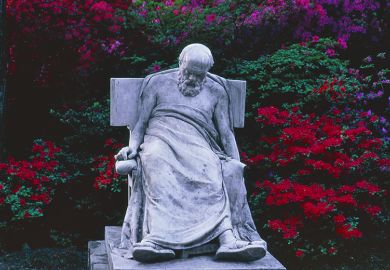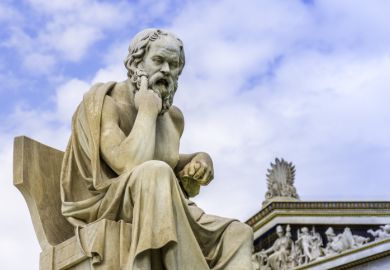Readers of Iris Murdoch will need no reminder of the value of approaching moral philosophy through fiction. Good fiction can provide the concreteness, the complexity of interaction, and the public exposure of depths of character that are the real meat of moral analysis. Unfortunately many contemporary moral philosophers have not learned this lesson, with the result that their writings frequently appear abstract, remote and trivial. Colin McGinn learned it, partly through writing fiction himself, and partly through volunteering to teach a course on philosophical ideas in literature at Rutgers University. The result is a book which I hope will start a new fashion. Apart from two opening chapters, in which he establishes his philosophical credentials, and which he recognises may well deter the general reader, it has all the qualities modern philosophical writing tends to lack. I found it substantial, absorbing and relevant.
We are asked to imagine two characters, one of whom derives pleasure from another's pain and is distressed by another's pleasure, and the other who has exactly the opposite reactions. Here is a fundamental moral divide, which clearly reveals the falsity of the claim that morality can be defined simply in terms of pleasure and pain. If sadistic violence is evil, it follows that not all pleasure is good. The evil master-at-arms in Melville's Billy Budd took pleasure in tormenting Billy on account of his very innocence and harmlessness. Iago was incited to revenge by envy of the happiness of others. Schadenfreude and other forms of malicious pleasure tap into the same stream which fed bear baiting and the desire for public executions. Does part of the pleasure of violent sports and spectacles lie in the arousal a similar sadistic frisson? Perhaps this is why other qualities, like sportsmanship, are so necessary to counteract the psychological perils.
The evil character's fundamental desire, according to McGinn, is to invert the other's values - to make the victim long for death but without actually causing it, because death would bring the pleasure of tormenting to an end. The seducer likewise takes particular pleasure in forcing the victim to die inwardly by the abandonment of his or her principles. Even rhetoric which seeks to persuade people against their will may to a lesser degree be driven by the same impulse. Envy, the deep feeling that one's life is intrinsically less valuable than that of others, frequently underlies the desire to do harm. But there is also a primitive pleasure in the infliction of pain, and it may be that the evils described here have their ultimate roots in this. Its existence may simply have to be accepted as a fact of human nature. To acknowledge this is not to justify it, but to recognise that "vice is no more enigmatic than virtue".
There is a difficulty in this thesis. In the two opening chapters McGinn has argued along lines, strongly reminiscent of G. E. Moore, that goodness is a conceptual primitive which cannot be analysed away into anything else. He goes on to argue that "ethical knowledge is not in any relevant respect inferior to scientific knowledge", indeed better because it does not rely on such a dubious process as induction. By contrast "we are innately predisposed to grasp ethical principles", in much the same way as we are predisposed to grasp the principles of language. Differences between the moral attitudes of different societies have been grossly exaggerated, and the relatively steady state of moral systems over recorded history suggests that they originate in a common human nature or folk psychology. This, in turn, must be understood as part of our evolutionary adaptation to a social environment. But - and here is the difficulty - if the propensity to do harm is also rooted in our evolutionary history, what are ultimate grounds for evaluating one as good and the other as evil?
I do not find any convincing answer in the book apart from the assertion that we already know what goodness is. The author is eager to exclude any vestige of religion, no doubt because he believes this would narrow the appeal of his argument. But the consequence is that his strong assertions about the objectivity of moral truths are left hanging, as it were, in a metaphysical void, which he then tries to fill with the concept of "beauty of soul". To go so far in giving ontological status to goodness, truth and beauty, and then to buck the last metaphysical hurdle, seems strangely perverse.
The aesthetic flavour of many moral terms, such as "fine", "pure", "rotten", "ugly" and "sick", has frequently been neglected by philosophers, despite their prevalence in ordinary conversation. McGinn argues for what he calls "an aesthetic theory of virtue", in which virtue coincides with beauty of soul and vice with ugliness of soul. It is an unfair convention that good people should so often be pictured as beautiful, and wicked people as ugly. But there is a proper sense in which aesthetic feelings of attraction or disgust can be added to moral judgments about their souls. The heroine in the film Brief Encounter, caught up in a wartime romance on a dingy railway station, managed to preserve a beauty of soul - greatly helped by Rachmaninov's Piano Concerto No 2 - despite the risks she was running in her clandestine meetings. Humbert Humbert in Nabokov's Lolita, on the other hand, was inwardly "a cesspoolful of rotting monsters behind his slow boyish smile", despite his beautiful command of language.
Oscar Wilde's The Picture of Dorian Gray makes use of the idea of beauty of soul, a soul which is in this instance transferred to Dorian Gray's portrait, and thereafter gradually reveals his inner dissoluteness and decay. The book explores what happens when aestheticism is allowed to replace morality, when life is conceived simply as a work of art to be fashioned for its own sake, apart from any consideration for the good of others. The evil here is not sadism but the abnegation of morality, made possible as Dorian Gray escapes the consequences of his inner repulsiveness by remaining outwardly beautiful. But in the end, of course, he has to face his repulsiveness as his portrait progressively exposes the true state of his soul. It is at this point that McGinn produces an interpretation which makes sense of an otherwise rather weak denouement. A straightforward reading seems to imply that when, at the climax of the story, Dorian stabs his portrait, the knife mysteriously stabs him instead, and the portrait is miraculously restored to its original beauty. Not so, says McGinn. In selling his soul Dorian became the picture, and the picture became him. The man who tried to make his life a work of art became one, only to discover that the aesthetic project without morality is self-refuting. To want to be nothing but beautiful is to make one's soul hideous. When that hideousness could no longer be borne, Dorian destroyed the picture, ie himself.
Frankenstein's creature faced the problem of hideousness too. Its tragedy was that its hideousness masked what was at first a kind and gentle disposition. It was only successive rejections which turned a longing for friendship into extreme hatred and the thirst for revenge. One of the most poignant moments in Mary Shelley's novel is when, after months spent hiding from and listening to a family of cottagers, and thereby learning their language, the creature at last ventures to reveal itself to the blind father of the family. It is well received, only to have all its hopes dashed when other members of the family return, and set upon it in horror. Later it saves a child from drowning and is shot and wounded because its physical ugliness invites misinterpretation of its actions. Turned by misfortune into a murderous monster, it promises to stop destroying Frankenstein's family if only he will create a mate for it as hideous as itself. But when nearing completion, the project is aborted on the grounds that such monsters are not to be trusted. Here then is a story the exact opposite of Dorian Gray's - a life blighted by ugliness, in contrast to one seduced by beauty.
But whom does the monster represent? McGinn answers, Everyman. This ugly rejected creature tells us about our human condition. Our bodies are assemblages of dead matter, put together from all kinds of horrors. Our beauty is only skin deep. Remove the skin, and what lies beneath is grotesquely repulsive. We are brought into the world against our will, only to be abandoned as the umbilical cord is cut, and we discover our isolation. Those who should love us and give us their entire attention treat us as if we were a burden. We are pitched into a hard world where people judge us mainly by our exterior. Life is a struggle against forces which will in the end defeat us. We are "separate, autonomous, solitary selves, from birth to death".
This is certainly a possible interpretation, and there are enough references in the story to Adam and his Creator to give it some plausibility. Natural sympathy with the creature also gives the story some of its appeal. We are invited to see ourselves writ large, haunted by anxieties and feelings of rejection, with which adolescents in particular are likely to sympathise.
I cannot help thinking, however, that the subtitle of the book - The Modern Prometheus - its setting within a voyage of scientific discovery which is later abandoned and Frankenstein's determination to make his name through "grand science", give equal importance to the more familiar theme of scientific and intellectual hubris. Those who persistently talk of Frankenstein as if he were the monster, may not be so wrong. There is something monstrous about a human being playing the role of God. And today we can appreciate the irony that, having done so, he immediately ran away from the terrible reality he had created.
One of the advantages of fiction as the raw material for moral philosophy is that it allows for precisely such ambiguities, as does real life. One of its disadvantages is that it is difficult to be sure in the end where one has arrived. I hope this book is a foretaste of a larger and more comprehensive study, which is also less dismissive of religion. It does not really make much sense to write about evil in fiction, and omit all references to writers like Dostoevsky, who cannot be understood outside their religious context. Nor can anyone exploring the relationship between ethics and aesthetics really afford to ignore Kierkegaard's Either/Or.
Raskolnikov, for instance, in Crime and Punishment commits an undeniably evil murder for motives which do not fit any of those McGinn considers. He wants to persuade himself that he is acting as a benefactor in ridding the world of "a vile noxious insect, an old pawnbroker woman, of use to no one". He is not an evil character who takes pleasure in the killing, nor a mean-spirited one who murders for a few roubles. He murders on principle, as one of the "extraordinary people", a Napoleon who can transgress the law and destroy the present order for the sake of something better. In fact he shares the same kind of intellectual hubris as Frankenstein. In Dostoevsky's eyes he has succumbed to the unholy intellectualism of Western Europe and the stirrings of nihilism in his own country. But when he has actually murdered, he knows full well that he is not a Napoleon but an aesthetic louse. His feelings may once have been compatible with a certain grandeur of soul, but he fatally misconstrues his place within the totality of things. His problem, for Dostoevsky, is ultimately spiritual.
Fiction allows these large questions to surface. McGinn, though he has given his readers a great deal of food for thought, has in the end skirted them. I hope he will be sufficiently encouraged by the reception of this book to widen his scope.
Lord Habgood is the former Archbishopof York.
Ethics, Evil and Fiction
Author - Colin McGinn
ISBN - 0 19 823716 2
Publisher - Oxford University Press
Price - £19.99
Pages - 186
Register to continue
Why register?
- Registration is free and only takes a moment
- Once registered, you can read 3 articles a month
- Sign up for our newsletter
Subscribe
Or subscribe for unlimited access to:
- Unlimited access to news, views, insights & reviews
- Digital editions
- Digital access to THE’s university and college rankings analysis
Already registered or a current subscriber?



